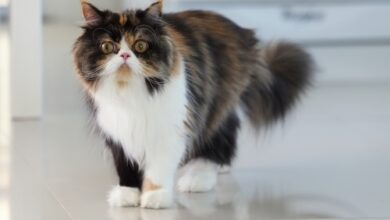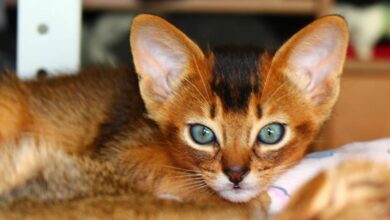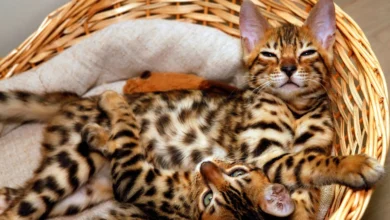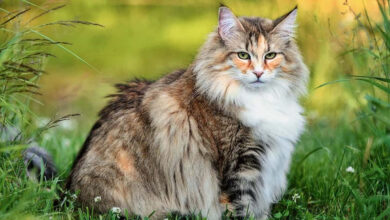Fiery Beauties with Enduring Charm: Tabby Cats

Frequently Asked Questions about Tabby Cats
Is tabby cat a friendly cat?
In general, yes – tabby cats tend to have friendly, mild-mannered personalities well-suited for family pets. As social animals, they enjoy human interaction and form strong bonds with their owners through play, affection and attention. Their curious yet adaptable natures help tabbies adjust smoothly to homes with children or other pets. While individual temperaments vary, most tabbies show outgoing, affectionate manners when properly socialized from kittens.
Are tabby cats expensive?
Tabby cat prices vary depending on factors like breed, age, health and whether they come from shelters or breeders. On average:
- Shelter tabbies are the most affordable at around $50-150 usually including basic care.
- Random-bred “moggie” tabbies from non-professional breeders range $150-300.
- Pedigreed non-show cat prices from reputable hobby breeders are $350-650.
- Top quality show potential kittens from champion lines can reach $650-1200.
Overall, tabbies occur across all budgets and their friendly personalities make them a great lower-cost pet option for many homes. Adopting from shelters helps animals most in need.
Can tabby cats eat fish?
In moderation and cooked rather than raw, fish can be an occasional healthy treat for tabby cats. However, it should not replace a nutritionally balanced diet. While cats are obligate carnivores, their systems are adapted for red meat rather than seafood which may cause diarrhea, vomiting, or other issues if eaten too frequently. Canned fish like sardines or small cooked pieces of white flaky fish as an occasional snack is generally safest in consultation with your vet. The key is variety and balance in your tabby’s diet for optimal health.
What is another name for a tabby cat?
Sometimes, tabby cats are referred to by other descriptive names highlighting their distinctive coats:
- Tabbies – Refers specifically to their striped or spotted patterns.
- Brindle – Describes tabbies with densely colored hair blending to pale hair rather than distinct markings.
- Calico or Tortoiseshell – Refers to tabbies with multiple colors like brown, black and orange patched randomly.
- Abyssinian cat – Has a similar agouti pattern but is a distinct natural breed from Africa.
Tabby cats have an iconic look and unique personality that has charmed people for centuries. Their coats blend beautiful patterns and vivid colors, while their curious natures keep families entertained. As one of the most common domestic cat coat patterns, tabbies come in a variety of breeds and colors.
Tabby cat breeds
While tabby patterning can appear in almost any breed, certain breeds are closely associated with the tabby look. Let’s explore some of the most popular tabby cat breeds found in Australia.
Domestic Shorthair
The domestic shorthair (DSH) is likely the most familiar tabby due to its prevalence as a random-bred pet. This breed lacks a pedigree but shares tabby patterning and features such as a medium build and short coat. DSH tabbies come in various colors and patterns. Their friendly, laid-back personalities make them a great starter pets for families.
American Shorthair
Similar to the DSH but with a recognized pedigree, American Shorthairs have bodies bred for dense muscle and power. Their round paws and large eyes give them a teddy bear-like appeal. While they come in many colors, their tabby coats are among the most recognized American Shorthair traits. Friendly and family-oriented, these mild-mannered cats bond strongly with their people.
British Shorthair
Like plump little Hobbits, British Shorthairs have stout bodies, round faces, and dense coats that tickle when petted. The tabby version has a dramatic pattern that stands out against its silver, bronze, or golden fur tones. Calm and charming, these cats thrive as lap warmers but also enjoy playtime. Highly adaptable to families with children or other pets.
Russian Blue
Sporting a silvery-blue coat with warm overtones, Russian Blues resemble elegant aristocrats. Their tabby variety has ghost-like pattern swirls, though they remain more subdued than other tabby coats. Shy initially but devoted companions, Russian Blues bond closely with one or two people as loyal familiar spirits.
Tabby cat personality
While individual personalities vary, most tabbies share a set of charms that make them well-suited for life as family pets. Let’s explore their temperament tendencies.
Curious and active
Tabbies love to explore their surroundings and stay mentally stimulated. Provide interactive toys to spark their natural curiosity and satiate their playful energies. Climbing, pouncing, and investigating boost their moods.
Adaptable and easygoing
Willing to bond with any owner who shows them kindness, tabbies adjust smoothly to homes with children or other pets. Their mild-mannered natures create easy companionship. Minimal grooming needs also make them low-maintenance pet options.
Affectionate and social
Tabbies bond closely with their people and enjoy mutual grooming sessions of petting and brushing. Ideally, own at least two tabbies so they can keep each other company during the day. Socializing them from kittens helps ensure friendly manners with guests.
Vocal communicators
Do not be surprised by talkative chirps, trills, meows, or purrs. Tabby voices reflect their emotional states; soothing tones reassure when stressed or pleased when content. Responding signal your care and commitment to the relationship.
In summary, tabbies typically form strong social attachments as balanced, easygoing friends for responsible cat owners. Choosing reputable breeders or shelters helps ensure well-socialized tabby companions.
Tabby cat lifespan
With proper veterinary care and nutrition, domestic tabby cats live an average of 12-15 years. However, optimal health and genetics can sometimes push lifespans even longer. Let’s delve deeper into factors impacting a tabby’s longevity.
Diet and exercise
Feeding a high-quality diet tailored to your tabby’s life stage supports its immune system and organ function. Daily play also keeps muscles toned and minds engaged. Avoid obesity which stresses joints and shortens lives.
Preventative healthcare
Routine checkups alongside vaccines and parasite preventatives safeguard against common infectious diseases. Dental cleanings every 1-2 years protect oral health, which is integral to overall wellness. Prompt care addresses any minor medical issues before they escalate.
Stress management
Minimize stress through gentle treatment, consistent routines, and a secure home environment. Stress weakens immune defenses leaving cats vulnerable to illness. Consider additional feline friends or interactive toys for indoor enrichment.
Genetics and behavior
Pedigreed tabbies from reputable breeders tend toward genetic robustness. Strays or ferals often have unknown histories impacting hardiness. A gentle demeanor reduces the likelihood of injuries from scrapes. Provide scratching posts and climbable havens over banned furniture areas.
In conclusion, outstanding nutrition, preventative healthcare, and stress-free living optimize the quality of the years that tabbies spend with loved ones. Most surpass decade-long lifespans with diligent care matched to individual needs.
Tabby cat price
As one of Earth’s most popular pets, tabby cats appear across all budgets. Let’s explore typical tabby purchase price points and factors influencing their costs.
Shelter tabbies
Community animal shelters aim to find every cat a home, often waiving adoption fees entirely for particular weeks. On average, expect a $50-$150 fee covering spay/neuter, vaccines and basic supplies. Sometimes small breed-specific rescue groups host cats.
Random-bred “moggies”
Advertised locally by breeders or re-homing owners, companionable random-bred tabbies without pedigrees range $150-$300 depending on age, health exams, and included items like carriers. Meet mother cats and see vet records when possible.
Pedigreed non-show cats
Breeders ethically raising specific breeds like British or Russian Blues typically charge $350-$650 per pet-quality kitten from registered parents. Purchasers gain knowledgeable breed support and assurance of breed standard qualities without emphasis on conformation.
Pedigreed show potential kittens
Top breeders of champion exhibition lines may sell top-quality kittens exhibiting superior type, structure, and markings for $650-$1200 if the potential for winning shows exists. Extensive health testing supports these investments.
Factors like coat color, age, intensity of training, and inclusion of supplies can shift individual tabby prices up or down within ranges. Overall, these friendly cats suit various budgets; always choose an ethical source and never pay deposits without meeting available cats first.
Tabby cat orange
Of all tabby coat colors, a fiery burnt orange captivates many. Let’s explore the genetics, patterns, and unique charms behind these magnetic ginger kitties.
Color genetics
All domestic cats result from genetic mutations within wild ancestors retaining camouflage coat patterns. Orange or ginger tabby color primarily depends on sex-linked alleles interacting with patterns inherited separately. Females need two orange genes, and males only need one for expression.
Coat patterns
Classical “Mackerel” stripes down the spine give tabbies their name from the fish. “Ticked” patterns appear as scattered colored hairs across a paler ground. Some show marbled swirls instead of neat demarcations. Regardless, all feature darker face masks enhancing those soulful almond eyes.
Temperament tendencies
Myth portrays orange cats as aggressively independent due to unusual genetics. In truth, every cat develops a unique personality informed by both nature and nurture. However, orange tabbies sometimes show goofier, more overtly affectionate temperaments bonding strongly with owners who treat them gently.
Health considerations
Some claim orange cats experience higher incidences of certain ailments due to an allele also boosting sensitivity. However, most major cat health organizations find no scientific evidence supporting this. With proper nutrition, care, and stimulus, orange tabbies average longevity similar to other domesticated lines.
Whether golden ray or copper penny, an orange tabby’s warm coat immediately catches the eye. Their distinct charm and affection create devoted bonds as memorable companions for many loving homes. Choose thoughtfully and provide optimal care for a feline friend of flaming passion.
Why tabby cats are so special
Despite their ubiquity as random-bred house pets, tabby cats embody special magic that has been appreciated differently by various cultures throughout centuries. Let’s explore their enduring enchantment.
Ancient folklore associations
Early Romans and Greeks revered tabbies almost as lucky talismans against evil spirits. Their striped coats resembled gods, like Zeus’ favored leopard. Scandinavian folklore called tabbies “ship cats” guiding Norse journeys voyaging to new lands. Chinese lucky money pouches still resemble tabby pelts for prosperity blessings today.
Artistic inspirations
Renowned painters like Rembrandt and Whistler crafted iconic masterpieces featuring tabbies as contemplative muses. Modern photographers worldwide adore capturing their unique markings at play. Since Chaucer, authors have woven their charming antics into literary works that elevate tabby reputations. Even today’s internet memes celebrate “caturdays” and tabby expressions.
Family companion
Tabbies endear themselves to communities globally through steadfast roles as gentle animal companions. Their easygoing natures suit households of all shapes and sizes. Children learn empathy, nurturing a tabby’s friendship through life lessons of responsibility and care. For elderly owners or those preferring low-maintenance pets, a tabby brings constant affection reducing loneliness.
During hard times, a tabby’s unconditional devotion lifts spirits. Their acceptance comforts differently abled individuals, PTSD victims or others needing unconditional acceptance. For creative types, a tabby inspires artwork or stories celebrating their inspiring essence. Wherever found, tabbies represent constancy amid everchanging world tides through fierce yet tender bonds with beloved people.
So, in summary, while “tabby” is the most recognized term, descriptors like brindle, patched, or agouti patterned are also used for cats sharing their iconic striped or marbled fur designs.



